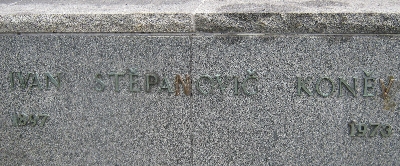
Many of us here in Prague, are beginning to think that someone has kidnapped Spring and early Summer, the weather having been cold and wet for most of May. So Sybille and I decided to take full advantage of a rare, fine, dry and partly sunny evening earlier this week, and take a walk through some of Prague’s wonderful green spaces.
We took the tram to Pražský hrad / Prague Castle. But instead of crossing Prašný most, the bridge over Jelení príkop, and entering the Castle complex, we turned left into Královská zahrada, the Royal Gardens. As well as a wonderful collection of mature trees, there were several rhododendron bushes still in flower – shades of our visit to Pruhonice Park the previous week.
From the Royal Gardens, there are splendid views of Prague Castle. This photo shows the towers at the eastern end of the Castle complex. However, surrounded by trees and other greenery, you could be forgiven for thinking it to be scene from a small historic village in the Bohemian countryside, rather than a location in the centre of the Czech capital.

At the eastern end of the Royal Gardens is Chotkovy sady, from where this view down to the Malostranská tram stop with Charles Bridge beyond, was taken. From this point, a pedestrian bridge allowed us to cross the road and tram tracks below, and enter a far bigger green space, Letenské sady or Letná Park, as it is commonly called in English.

Letná Park occupies a plateau from which a steep slope goes down to the Vltava river. Walking along the path at the top of the slope, there are extensive views across the whole of that part of Prague that lies on the eastern side of the river. But sitting on top of a massive plinth and occupying the best viewpoint of all, is this slightly incongruous metronome. At least when we saw the metronome on our walk earlier this week, it was actually working. More often than not, it is stationary!
The metronome was erected in 1991, but the massive plinth on which it sits, has a far longer history going back to late 1949, only eighteen months after the coup that brought the Communist Party to power in February 1948. For on it once stood the largest group statue in Europe, measuring 15.5 metres in height and 22 metres in length.
Seeking to kowtow to the Soviet Union, the Central Committee of the Communist Party in Czechoslovakia decided to build a massive statue of Joseph Stalin. It took them five and a half years to construct it and, by the time it was unveiled on 1st May 1955, Stalin had already been dead for over two years.

As you can see, the group statue was a classic example Communist era art on a gigantic scale. Stalin stands proudly overlooking the Vltava River, with archetypal workers and soldiers lining up behind him. The statue was informally known as ‘Fronta na maso‘, the ‘meat queue’, which was a daily part of life at that time. I am given to understand that there were also some far more descriptive titles – those that referred to what comrades standing behind Stalin, might be doing to his rear 🙂 As long as they are not too offensive, I’d love to know what these were, via comments on this post.
Less than a year after the statue was unveiled, Nikita Khrushchev denounced Stalin, both for his dictatorial rule and his cult of personality. Thus, this grand monument became an increasing embarrassment to the Czechoslovak Communist hierarchy. Therefore, in October 1962, the whole colossus was blown up with the help of 800 kg of explosives.
From the platform, immediately below the metronome, there is a view straight across Cechuv most, towards Staromestké námestí / Old Town Square. The street from the bridge to the square is called Parižská / Paris Street. Either side of Parižská, are some of the most exclusive and expensive shops in Prague. It is a view I suspect, that Stalin would not enjoy. So it is probably good that he no longer has to observe it 🙂






































